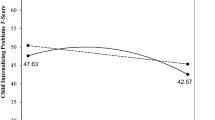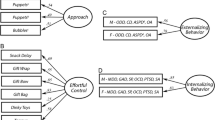Abstract
In a cross-sectional study of 83 unmedicated boys, 6 to 16 years of age (M = 10.6, SD = 2.1), attending public (N = 48) and therapeutic schools for behaviorally disturbed children (N = 35), we examined relations of externalizing psychopathology to age-dependent change in performance on cognitive and motivational dimensions of impulse control assessed by laboratory tasks. When we controlled for internalizing symptoms and IQ or school achievement, all children showed improving competence with increasing age on both dimensions over the age range of the sample. Children with externalizing problems performed more poorly on both dimensions at all ages than children without such problems. Comparing age-dependent competence for the two groups, a model of convergent maturation in cognitive aspects of impulse control, and a model depicting a stable deficit in motivational aspects of impulse control in those children with externalizing behavior problems, relative to those without such problems, emerged. Studies of individual growth in impulse control, together with correlates of growth, are needed to validate these observations.
Similar content being viewed by others
REFERENCES
American Psychiatric Association. (1994). Diagnostic and statistical manual of mental disorders (4th ed.). Washington, DC: Author.
Bachorowski, J. A., & Newman, J. P. (1990). Impulsive motor behavior: Effects of personality and goal salience. Journal of Personality and Social Psychology, 58, 512-518.
Barkley, R. A. (1991). The ecological validity of laboratory and analogue assessment methods of ADHD symptoms. Journal of Abnormal Child Psychology, 19, 149-178.
Barkley, R. A. (1997). Behavioral inhibition, sustained attention, and executive functions: Constructing a unifying theory of ADHD. Psychological Bulletin, 121, 65-94.
Daugherty, T. K., & Quay, H. C. (1991). Response perseveration and delayed responding in childhood behavior disorders. Journal of Child Psychology and Psychiatry, 32, 453-461.
Derryberry, D., & Rothbart, M. K. (1997). Reactive and effortful processes in the organization of temperament. Development and Psychopathology, 9, 633-652.
Fowles, D. C. (1980). The three-arousal model: Implications of Gray's two factor learning theory for heart rate, electrodermal activity, and psychopathy. Psychophysiology, 17, 87-104.
Fowles, D. C. (1988). Psychophysiology and psychopathology: A motivational approach. Psychophysiology, 25, 373-391.
Golden, C. J. (1978). Stroop Color and Word Test: A manual for clinical and experimental uses. Chicago: Stoeliting Co.
Gray, J. (1987). Perspectives on anxiety and impulsivity. Journal of Research in Personality, 21, 493-509.
Hale, S. (1990). A global developmental trend in cognitive processing speed. Child Development, 61, 653-663.
Jennings, J. R., van der Molen, M. W., Pelham, W., Brock-Debski, K., & Hoza, B. (1997). Inhibition in boys with attention deficit hyperactivity disorder as indexed by heart rate change. Developmental Psychology, 33, 308-318.
Kail, R. (1991). Developmental change in speed of processing during childhood and adolescence. Psychological Bulletin, 109, 490-501.
Kalverboer, A. F. (1989). Merits and limitations of the information processing approach for the study of attentional deficit disorder. In L. M. Bloomingdale & J. M. Swanson (Eds.), Attention deficit disorder: Current concepts and emerging trends in attentional and behavioral disorders of childhood (pp. 273-282). Supplement to the Journal of Child Psychology and Psychiatry. Oxford: Pergamon Press.
Kelley, T. L., Ruch, G. M., & Terman, L. M. (1992). Stanford Achievement Test (8th ed.). Harcourt, Brace, Jovanovich.
Kerr, M., Tremblay, R., Pagani, L., & Vitaro, F. (1997). Boys' behavioral inhibition and the risk of later delinquency. Archives of General Psychiatry, 54, 809-816.
Kindlon, D. J. (1998). The measurement of attention. Child Psychology and Psychiatry Review, 3, 72-78.
Kindlon, D., Mezzacappa, E., & Earls, F. (1995). Psychometric properties of impulsivity measures: Temporal stability, validity and factor structure. Journal of Child Psychology and Psychiatry, 36, 645-661.
Kochanska, G., Murray, K., & Coy, K. C. (1997). Inhibitory control as a contributor to conscience in childhood: From toddler to early school age. Child Development, 68, 263-277.
Kochanska, G., Murray, K., Jacques, T. Y., Koenig, A. L., & Vandegeest, K. A. (1996). Inhibitory control in young children and its role in emerging internalization. Child Development, 67, 490-507.
Lahey, B. B., & Loeber, R. (1994). Framework for a developmental model of Oppositional Defiant Disorder and Conduct Disorder. In D. K. Routh (Ed.), Disruptive behavior disorders in childhood (pp. 139-180). New York: Plenum Press.
Loeber, R., Wung, P., Keenan, K., Giroux, Stouthamer-Loeber, van Kammen, & Maughan, (1993). Developmental pathways in disruptive child behavior. Development and Psychopathology, 5, 103-134.
Logan, G. D., Cowan, W. B., & Davis, K. A. (1984). On the ability to inhibit simple and choice reaction time responses: A model and a method. Journal of Experimental Psychology: Human Perception and Performance, 10, 276-291.
Loong, J. W. (1989). The Color-Word Test, San Luis Obispo, CA: Wang Neuropsychological Laboratory.
McBurnett, K., Lahey, B. B., Frick, P. J., Risch, C., Loeber, R., Hart, E. L., Christ, M. C., & Hanson, K. S. (1991). Anxiety, inhibition, and conduct disorder in children: II. Relation to salivary cortisol. Journal of the American Academy of Child and Adolescent Psychiatry, 30, 192-196.
Mezzacappa, E., Kindlon, D., Saul, J. P., & Earls, F. (1998). Executive and motivational control of performance task behavior and autonomic heart rate regulation in children: Physiologic validation of two-factor solution inhibitory control. Journal of Child Psychology and Psychiatry, 39, 525-532.
Milich, R., Hartung, C. M., Martin, C. A., & Haigler, E. D. (1994). Behavioral disinhibition and underlying processes in adolescents with disruptive behavior disorders. In D. K. Routh (Ed.), Disruptive behavior disorders in childhood (pp. 109-138). New York: Plenum Press.
Mischel, W., Shoda, Y., & Rodriguez, M. I. (1989). Delay of gratification in children. Science, 244, 933-938.
Moffitt, T. (1993). The neuropsychology of conduct disorder. Development and Psychopathology, 5, 135-152.
Newman, J. P., & Kosson, D. S. (1986). Passive avoidance learning in psychopathic and nonpsychopathic offenders. Journal of Abnormal Psychology, 95, 252-256.
Newman, J. P., Kosson, D. S., & Patterson, C. M. (1992). Delay of gratification in psychopathic and nonpsychopathic offenders. Journal of Abnormal Psychology, 101, 630-636.
Newman, J. P., Patterson, C. M., & Kosson, D. S. (1987). Response perseveration in psychopaths. Journal of Abnormal Psychology, 96, 145-148.
Oosterlaan, J., Logan, G. D., & Sergeant, J. A. (1998). Response inhibition in AD/HD, comorbid AD/HD + CD, anxious and control children: A meta-analysis of studies with the Stop Task. Journal of Child Psychology and Psychiatry, 39, 411-425.
Oosterlaan, J., & Sergeant, J. A. (1996). Inhibition in ADHD, aggressive and anxious children: A biologically based model of child psychopathology. Journal of Abnormal Child Psychology, 24, 19-36.
Patterson, C. M., Kosson, D. S., & Newman, J. P. (1987). Reaction to punishment, reflectivity, and passive avoidance learning in extraverts. Journal of Personality and Social Psychology, 52, 565-575.
Pennington, B. F., & Bennetto, L. (1993). Main effects or transactions in the neuropsychology of conduct disorder. Development and Psychopathology, 5, 153-164.
Pennington, B. F., & Ozonoff, S. (1996). Executive function and developmental psychopathology. Journal of Child Psychology and Psychiatry, 37, 51-87.
Pliszka, S. R. (1992). Co-morbidity of attention deficit hyperactivity disorder and overanxious disorder. Journal of the American Academy of Child and Adolescent Psychiatry, 31, 197-203.
Posner, M. I., & Rothbart, M. K. (1998). Attention, self-regulation and consciousness. Philosophical Transactions of the Royal Society of London—Series B: Biological Sciences, 353, 1915-1927.
Quay, H. C. (1988). Attention deficit disorder and the behavioral inhibition system: The relevance of the neuropsychological theory of Jeffrey A. Gray. In L. M. Bloomingdale & J. Sergeant (Eds.), Attention deficit disorder: Criteria, cognition, intervention (pp. 117-125), Oxford: Pergamon Press.
Quay, H. C. (1993). The psychobiology of undersocialized aggressive conduct disorder: A theoretical perspective. Development and Psychopathology, 5, 165-180.
Quay, H. C., & Peterson, D. R. (1987). Manual for the Revised Behavior Problem Checklist. Coral Gables, FL: University of Miami.
Reitan, R. M. (1971). Trailmaking Test results for normal and brain damaged children. Perceptual and Motor Skills, 33, 575-581.
Scerbo, A., Raine, A., O'Brien, M., Chan, C. J., Rhee, C., & Smiley, N. (1990). Reward dominance and passive avoidance learning in adolescent psychopaths. Journal of Abnormal Child Psychology, 18, 451-463.
Schachar, R., & Logan, G. D. (1990). Impulsivity and inhibitory control in normal development and child psychopathology, Developmental Psychology, 26, 710-720.
Schachar, R., Tannock, R., Marriott, M., & Logan, G. (1995). Deficient inhibitory control in attention deficit hyperactivity disorder. Journal of Abnormal Child Psychology, 23, 411-437.
Seguin, J. R., Pihl, R. O., Harden, P. W., Tremblay, R. E., & Boulerice, B. (1995). Cognitive and neuropsychological characteristics of physically aggressive boys. Journal of Abnormal Psychology, 104, 614-624.
Sergeant, J. A., & van der Meere, J. J. (1988). What happens after a hyperactive commits an error? Psychiatry Research, 28, 157-164.
Shapiro, S. K., Quay, H. C., Hogan, A. E., & Schwartz, K. P. (1988). Response perseveration and delayed responding in undersocialized, aggressive conduct disorder. Journal of Abnormal Psychology, 97, 371-373.
Siegel, R. A. (1978). Probability of punishment and suppression of behavior in psychopathic and nonpsychopathic offenders. Journal of Abnormal Psychology, 87, 514-522.
Sonuga-Barke, E. J. S., Taylor, E., Sembi, S., & Smith, J. (1992). Hyperactivity and delay aversion: I. The effect of delay on choice. Journal of Child Psychology and Psychiatry, 33, 387-398.
Stroop, J. R. (1935). Studies of interference in serial verbal reactions. Journal of Experimental Psychology, 18, 643-662.
van der Meere, J. J., Vreeling, H. J., & Sergeant, J. (1992). A motor presetting study in hyperactive, learning disabled and control children. Journal of Child Psychology and Psychiatry, 33, 1347-1354.
Wallace, J. F., Newman, J. P., & Bachorowski, J. A. (1990). Failures of response modulation: Impulsive behavior in anxious and impulsive individuals. Journal of Research in Personality, 25, 23-44.
Weyandt, L. L., & Willis, W. G. (1994). Executive functions in school aged children: Potential efficacy of tasks in discriminating clinical groups. Developmental Neuropsychology, 10, 27-38.
Wechsler, D. (1991). Manual for the Wechsler Intelligence Scale for Children (3rd ed.). The Psychological Corporation, (pp. 208-209) New York: Harcourt Brace Jovanovich.
Williams, B. R., Ponesse, J. S., Schachar, R. J., Logan, G. D., & Tannock, R. (1999). Development of inhibitory control across the lifespan. Developmental Psychology, 35, 205-213.
Zahn, T. P., Kruesi, M. J. P., & Rapoport, J. L. (1991). Reaction time indices of attention deficits in boys with disruptive behavior disorders. Journal of Abnormal Child Psychology, 19, 233-252.
Zoccolillo, M. (1993). Gender and the development of conduct disorder. Development and Psychopathology, 5, 65-78.
Author information
Authors and Affiliations
Additional information
Project on Human Development in Chicago Neighborhoods
Rights and permissions
About this article
Cite this article
Mezzacappa, E., Kindlon, D. & Earls, F. Relations of Age to Cognitive and Motivational Elements of Impulse Control in Boys With and Without Externalizing Behavior Problems. J Abnorm Child Psychol 27, 473–483 (1999). https://doi.org/10.1023/A:1021936210844
Issue Date:
DOI: https://doi.org/10.1023/A:1021936210844




